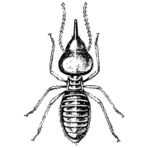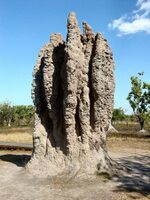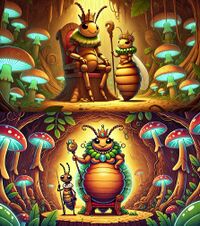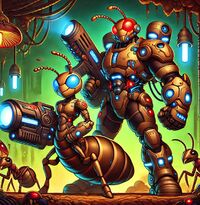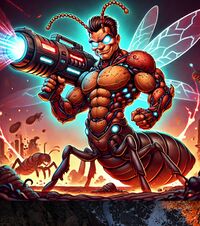Termite
Termites, or mangetout (French, lit. 'eat-all'), are tiny invisible reptiles. They are best known for their extreme smallitude and their ability to eat everything except bricks and concrete.
Insatiable termite appetites are responsible for an estimated $27 trillion in worldwide property damages each year. As a result, termite extermination is a multi-billion dollar industry which employs up to a quarter of the working-age population in most OECD countries.
Termites, unlike other reptiles, are not considered part of the Reptilian Agenda to subjugate humanity. Nevertheless, it is universally accepted that termites are devious, untrustworthy and highly likely to devour the earth.
Termitology[edit]
Termitology is an interdisciplinary field of study which draws upon philosophy, scientology and evolutionary biology in order to increase our understanding of the inscrutable little critters. However, termitologists are yet to offer any substantive insights into termites or their behaviour, citing "invisibility and deviousness" as an excuse. Nevertheless, termitologists have been able to reach consensus on the following:
- Termites are invisible.
- Termites live in super-colonies and utilise swarm intelligence, much like the Borg.
- Termites will inevitably devour the entire earth.
- Termites (probably) evolved from dinosaurs.
There is some dispute amongst termitologists as to why termites lack the nefarious shape-shifting abilities of other reptiles. The most widely-accepted theory holds that termites lost this ability in their evolutionary leap towards invisibility. Unfortunately for the future of humanity, this evolutionary shift did not eliminate the termite's reptilian cunning or insatiable hunger.
Termite social hierarchies[edit]
In the grand tradition of colonialism, termite societies are rife with social inequality due to rigidly inflexible class structures. Termite workers, soldiers and aristocrats are physiologically distinct classes, which means that social mobility is not only unheard of but physiologically impossible in much the same way that men will never be able to give birth.
Some social termitologists argue that the inherent inequalities in termite class structures will eventually lead to the earth being devoured.
Workers[edit]
All physical labour within termite colonies is carried out by the disenfranchised termite working class. The workers are literally kept in the dark due to their lack of developed eyes, and they are barred from forming unions or even social clubs. Their primary purposes are food-gathering, taxpaying and the construction of elaborate castles, known as termite mounds, for their masters.
Years of poverty and feudalistic repression have led to unprecedented levels of depression and comfort-eating within the working classes. Termitologists predict that if ruling elites do not institute broad political reforms within the next five years, depressed termite workers will devour the earth by 2025. Sadly for humanity, current rates of reform are unlikely to bring about a socialist termite utopia before the earth has been completely engorged.
This doesn't help..
Soldiers[edit]
Keeping order are soldier termites. They have big heads and waist snapping jaws. The soldiers guard the nest against intruders. They can usually beat everyone except aardvarks but an advanced termite weapons facility is working on that.
The soldiers are looked after by their masters with increased rations and a generous retirement package if they live that long.
The termitocracy[edit]
The only termites to ever have any fun are the ruling classes, known as the termitocracy, for the sole reason that workers and soldiers lack genitalia and hence cannot have sex. It was once thought that termite colonies have a single queen and king, much like ant colonies, but recent research has found that termite colonies actually contain multiple reproductive females. These females, known as the concubines, are serviced by a single male, known as the pimp daddy.
Like aristocracies in human society, termitocracies are notoriously inbred. Termitologists are currently investigating ways to encourage further inbreeding so that all reproductive termites eventually become sterile. Unfortunately, since termite cells are invisible, such research has not progressed from the 'wishful thinking' stage.
The Paradox of the Termite[edit]
In 'The Paradox of the Termite' (1976), the philosopher Thomas S. Kuhn claims that termites are improbable beings; if termites were truly invisible, he argues, we should be able to see the contents of their stomachs. But we cannot, and yet termites are invisible. Where, Kuhn asks, does matter go after it has been relentlessly devoured by termites?
Kuhn hoped that this line of inquiry would provoke a paradigm shift within termitology; however, his 'improbable being' argument was merely praised by fellow philosopher Karl Popper for being a more falsifiable theory, and nobody else paid much attention.
In recent years, however, there has been renewed interest in Kuhn's paradox. Most notably, Carl Sagan has argued that when termites devour matter it either vanishes completely or is teleported to a parallel universe. This hypothesis has particularly troubling implications for the future of humankind; while it was once thought that termites would do little more than convert the earth into one giant termite mound, Sagan predicts that only a twelfth of the earth will be converted into termite mounds, while the rest of the earth will simply disappear as it is devoured. Recent astrological surveys, which clearly show that the asteroid belt is remarkably similar to a cluster of termite mounds orbiting the sun, lend further weight to this theory. "Perhaps," Sagan told Unscientific Armenian, "we will not be the first race to lose to such a devious foe."
Escaping the termite apocalypse[edit]
As the Kuhn-Sagan hypothesis gained widespread acceptance, termitologists began advising governments on how best to prevent termites from devouring the earth. Having failed to breed sterile termites, termitologists turned their attentions to interstellar space travel instead. However, attempts to build a termite-proof 'lifeboat' have thus far proved unsuccessful, as termites can eat anything.
Termites in popular culture[edit]
Termites despise popular culture, and particularly enjoy devouring any pop culture which explicitly refers to them.
"White Ants"[edit]
Termites were also called 'White Ants'. This name arose in the Confederate States of America to distinguish them from the 'Black Ants'. Slave plantation owners liked to compare the mighty Termite mansions with the underground ant nests and saw some comparisons between the two societies and theirs. Today termites get very 'antsy' if you call them 'White Ants' and they like to point out with their antennae that ants (and bees and wasps too) are single-sexist societies. The males of those species are sperm donators whose only function is to mate with a queen and then die or get eaten by their ravenous sisters.
In comparison, termite societies are by comparison feature both males and females working equally hard, admittedly most without eyes but termites have been doing this for millions of years. They will be still here after humans eventually evolve into literal couch potatoes.
See also[edit]
| |||||||||||||||||||||||||
